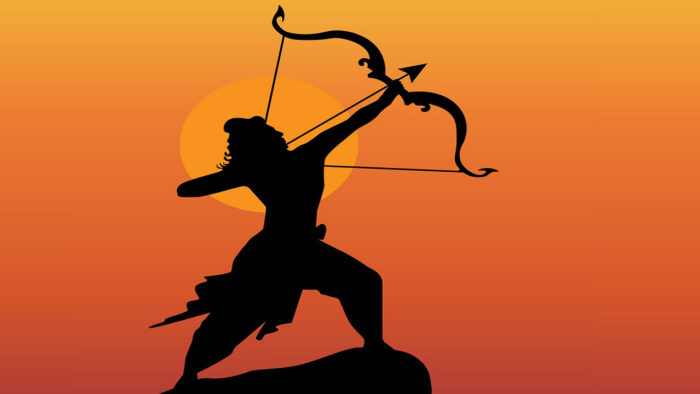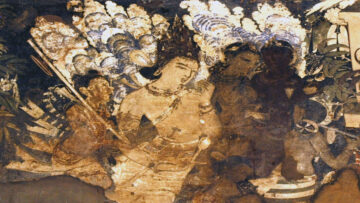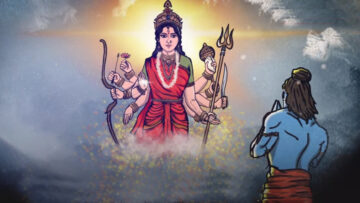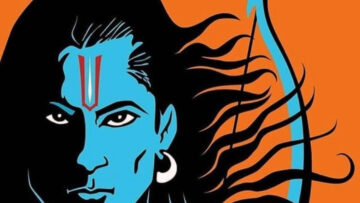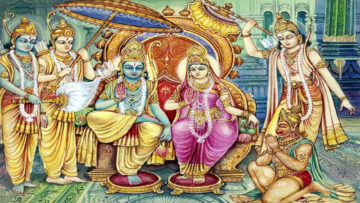रामोरामोरामइतिप्रजानामभवन्कथाः।
रामभूतंजगदभूत्रामेराज्यंप्रशासति।।
(rāmorāmorāmaitiprajānāmabhavankathāḥ।
rāmabhūtaṃjagadabhūtrāmerājyaṃpraśāsati।।)
Valmiki Ramayana 6.128.103।।
“Raama, Raama, Raama,” was the only story that echoed among the people. It was as if the entire world was being pervaded by Raama. Such was the rule of Raama.”
Something similar was witnessed by India over the past few months. The pious tithi of Paush Shukla dwaadashi marked the return of Raama to his timeless kingdom Ayodhya. All eyes were focussed on the holy janmasthaanateertha, glorified in the hindu scriptures. People from different regions of the country were singing the glories of the beautiful Lord in diverse ways. The entire landscape drowned in an ocean of ecstasy. It was as if tears of joy sprang down the 1000 eyes of the ViraatPurusha, on the return of the son of Kausalyaa.
Such is the effect of Raama that this return has become a personal victory for the people . And why not? After all it’s Raama,who, from the vast stretches of Himalayas to the depth of the Indian Ocean, binds this country in a thread of cultural unity. The multitude of Ramayanas is a testimony to this fact. What is the cause of this affinity towards Raama? Can a mere legend of a king make such an impact on the conscience of the people? If it could then there are far more illustrious emperors with their far more valorous sagas ensconced in the Hindu texts. But all the poets over the centuries have unanimously glorified the herder of monkeys and bears. Why?
Poet Jayadeva tried to say something in this regard in his ‘PrasannaRaghavam’
“स्वसूक्तीनांपात्रंरघुतिलकमेकंकलयतांकवीनांकोदोष: सतुगुणगणानामवगुण”
(svasūktīnāṃpātraṃraghutilakamekaṃkalayatāṃkavīnāṃkodoṣa: satuguṇagaṇānāmavaguṇa)
“What is the fault of the poets that in glorifying the sadgunas (virtues) they end up glorifying Raamachandra . It’s the fault of the gunas of Raama.”
In general, seeking pleasure in the same thing time and again, makes that thing lose its charm. But the longing for the story of Raama has been ever new among the Indian masses. The humongous literature on Raama wouldn’t have existed in India if I was merely exaggerating. The successful re- run of Ramanand Sagar’s Ramayan during the lockdown reaffirms the aforesaid assertion. Our inquiry about this never ending love for Raama, like every other inquiry, shall find its conclusion in the concluding parts of the Vedas- The Upanishads. It’s the declaration of the great Yaagyavalkya
नवाअरेसर्वस्यकामायसर्वंप्रियंभवत्यात्मनस्तुकामायसर्वंप्रियंभवति
(navāaresarvasyakāmāyasarvaṃpriyaṃbhavatyātmanastukāmāyasarvaṃpriyaṃbhavati)
BrihadarayankUpanishad -2.4.5
“Verily, not for the sake of the All, my dear, is the All loved, but it is loved for the sake of the Self (Aatman).”
And this self of the Upanishads is none other than Raama –
रामःपरात्माप्रकृतेरनादिरानन्दएकःपुरुषोत्तमोहि
(rāmaḥparātmāprakṛteranādirānandaekaḥpuruṣottamohi)
AdhyaatmaRaamaayana- 1.1.17।।
Which is why, this love for Raama is different from the love of ephemeral objects of the world. It doesn’t get affected by the constraints of space, time and trends.
Many thinkers, scholars, poets, and historians have tried to view the Ramayana with their own lenses. Some saw it as a bardic tale of a Prince of Ayodhya, some as a figment of imagination. Some saw it as a great prose, and some used it for their own propaganda. But we shall try to understand what the creators of the Ramacharitra themselves wanted to convey. In this regard, instead of relying on somebody’s opinion, we shall rely on the very own words of those poets.
Raama of Vaalmiki
We begin with the ‘Adikavi’ Vaalmiki.
At the very onset of his Ramayana, Vaalmiki makes a declaration that he composed this saga and taught it to his disciples, so that the essence of Vedas is explained.
वेदोपबृंहणार्थायतौअग्राहयतप्रभुः
(vedopabṛṃhaṇārthāyatauagrāhayataprabhuḥ)
VaalmikiRamayana- 1.4.6।।
The detailed analysis pertaining to Pramana and Prameya has been done in another write up .Curious people can go through the Link.
If the hagiography of a prince were the essence of the Vedas then the Vedas are merely retelling what can be known otherwise. Then Vedas are of no authority in the Hindu theology. But Vaalmiki is not glorifying an ordinary prince. He is trying to demystify the ineffable deeds of Lord Narayana Himself. Maharishi himself says in Baalakaanda-
इत्येतद्वचनंश्रुत्वासुराणांविष्णुरात्मवान्।
पितरंरोचयामासतदादशरथंनृपम्।।
(ityetadvacanaṃśrutvāsurāṇāṃviṣṇurātmavān।
pitaraṃrocayāmāsatadādaśarathaṃnṛpam।।)1.16.8।।
“Hearing the Devtas, Vishnu the lord of all jeevas decided to make Dasrath his father.”
ततोयज्ञेसमाप्तेतुऋतूनांषट्समत्ययुः।
ततश्चद्वादशेमासेचैत्रेनावमिकेतिथौ।। 1.18.8
नक्षत्रेऽदितिदैवत्येस्वोच्चसंस्थेषुपंचसु।
ग्रहेषुकर्कटेलग्नेवाक्पताविंदुनासह।।1.18.9
प्रोद्यमानेजगन्नाथंसर्वलोकनमस्कृतम्।
कौसल्याजनयद्रामंसर्वलक्षणसंयुतम्।। 1.18.10।।
(tatoyajñesamāptetuṛtūnāṃṣaṭsamatyayuḥ।
tataścadvādaśemāsecaitrenāvamiketithau।। 1.18.8
nakṣatre’ditidaivatyesvoccasaṃstheṣupaṃcasu।
graheṣukarkaṭelagnevākpatāviṃdunāsaha।।1.18.9
prodyamānejagannāthaṃsarvalokanamaskṛtam।
kausalyājanayadrāmaṃsarvalakṣaṇasaṃyutam।। 1.18.10।।)
“Six seasons (one year) passed after the completion of the sacrifice. In the twelfth month of Chaitra on the ninth day (of the bright fortnight), with Aditi as presiding deity when the star Punarvasu was in the ascendent and the five planets Sun, Mars, Saturn, Jupiter and Venus, were exalted in their own house in karkatalagna, when Brihaspati was in conjunction with the Moon, Kausalya gave birth to a son: a facet of Visnu, Lord of the entire universe who received obeisance from all the worlds and was adorned with all auspicious signs, the venerable one to perpetuate the Ikshvaku race.”
Now some people opine that Baalakanda is a later addition and hence it cannot be taken as evidence of Rama’s divinity. But let’s look at the parts which aren’t considered “Later additions”. In the AyodhyaKand Vaalmiki says-
सूर्यस्यापिभवेत्सूर्योह्यग्नेरग्निःप्रभोःप्रभोः।
श्रियश्चश्रीर्भवेदग्र्याकीर्त्याःक्षमाक्षमा।। 2.44.15।।
दैवतम्दैवतानाम्चभूतानाम्भूतसत्तमः।
तस्यकेह्यगुणादेविवनेवाप्यथवापुरे।। 2.44.16।।
(sūryasyāpibhavetsūryohyagneragniḥprabhoḥprabhoḥ।
śriyaścaśrīrbhavedagryākīrtyāḥkṣamākṣamā।। 2.44.15।।
daivatamdaivatānāmcabhūtānāmbhūtasattamaḥ।
tasyakehyaguṇādevivanevāpyathavāpure।। 2.44.16।।)
“Rama is the Sun (light) of the Sun, fire (splendour) of the fire, master (command) of masters, prosperity of the prosperous, the fame of the famous, forbearance of the forbearing, god of the gods and supreme among all beings. Whether he dwells in the forest or in the city, he has no demerit whatsoever.”
These are features of the Brahm of the Vedanta, and not of an ordinary prince.
In the Sundara Kaanda it has been said-
सर्वान्लोकान्सुसंहृत्यसभूतानसचराचरान्।
पुनरेवतथास्रष्टुंशक्तोरामोमहायशाः।।
(sarvānlokānsusaṃhṛtyasabhūtānasacarācarān।
punarevatathāsraṣṭuṃśaktorāmomahāyaśāḥ।।) 5.51.39।।
“Illustrious Raama can put an end to and dissolve all creatures including both movable and immovables of all worlds. He can recreate all of them in the same way. He has such divine powers.”
Showing Raama as protector of those seeking His refuge (Sharnaagatavatsala) Vaalmiki makes his protagonist say-
सकृदेवप्रपन्नाय तवास्मीतिचयाचते।
अभयंसर्वभूतेभ्यो ददाम्येतद् व्रतंमम।।
(sakṛdevaprapannāya tavāsmīticayācate।
abhayaṃsarvabhūtebhyo dadāmyetad vrataṃmama।।)
Vaalmiki Ramayana 6.18.33
“He who seeks refuge in me, saying only once – ‘I am yours’, I give him protection against all beings, this is my solemn vow”
It’s similar to सर्वधर्मान्परित्यज्य (sarvadharmānparityajya) of the Bhagvad Gita.
And then the seer clearly says-
अक्षरंब्रह्मसत्यंचमध्येचान्तेचराघव।।
लोकानांत्वंपरोधर्मोविश्वक्सेनश्चतुर्भजः।।
(akṣaraṃbrahmasatyaṃcamadhyecāntecarāghava।।
lokānāṃtvaṃparodharmoviśvaksenaścaturbhajaḥ।।)
6.117.14
“You are Brahm of Upanishadas, the imperishable, the Truth abiding in the middle as well as at the end of the universe. You are the supreme righteousness of people, whose powers go everywhere. You are the four-armed Vishnu.”
As Bhagvatam says for Krishna – ‘कृष्णस्तुभगवान्स्वयं’ (kṛṣṇastubhagavānsvayaṃ), similarly Vaalmiki says for Rama –
त्वंत्रयाणांहिलोकानामादिकर्तास्वयंप्रभुः
(tvaṃtrayāṇāṃhilokānāmādikartāsvayaṃprabhuḥ) ।6.117.19।।
“You are the creator of the three worlds, The God himself”.
Showing oneness of Rama and Krishna Vaalmiki says-
कृष्णश्चैवबृहद्बलः
(kṛṣṇaścaivabṛhadbalaḥ)।। 6.117.17।।
“O Rama ! You are the valiant Krishna”
If one reads Uttarkanda then things become quite clear. But since people consider it a later addition as well, we didn’t rely on it. The other kandas are self-sufficient to describe the reality of Raama.
Raama of Vyaasa
It’s said about sage Vyaasa
अचतुर्वदनोब्रह्माद्विबाहुरपरोहरि:।
अभाललोचन:शम्भु: भगवान्बादरायण।।
(acaturvadanobrahmādvibāhuraparohariḥ।
abhālalocana:śambhu: bhagavānbādarāyaṇa।।)
MahabharatAdiparva.
“Vyaasa is Brahmaa without four faces, Vishnu with two arms and Shiva without an eye on forehead.”
The division of one Veda into four parts for the convenience of the masses, is attributed to sage Vyaasa only. He composed the Mahabharata to take the essence of Vedas to every household of the Bhaaratavarsha. He explained the entire Vedanta in the form of aphorisms which are also known as Brahm sutras. Traditionally the composition of 18 Puraanas too is attributed to Him.
It won’t be wrong to say that a sage of this stature is very much enamored of Raama. In the epic Mahabharat only he got multiple opportunities to sing the glories of Raama. Within the VanaParva of the epic there is a Raamopakhyanaparva, which is a dialogue between Yudhishthir and Markandeya. It’s a detailed legend of Rama extending up to 16 chapters. There, when Devas, troubled by the tyrannical reign of Raavana, seek the refuge of the Prajapati, the Prajapati clearly says:
तदर्थमवतीर्णोऽसौमन्नियोगाच्चतुर्भुज:।।
विष्णु: प्रहरतांश्रेष्ठ: सतत्कर्मकरिष्यसि।।
(tadarthamavatīrṇo’saumanniyogāccaturbhujaḥ।।
viṣṇu: praharatāṃśreṣṭha: satatkarmakariṣyasi।।)
Mahabharat.VanaParva. 273.5।।
“In order to destroy Raavana, I pleaded to the four armed Lord Vishnu. Vishnu, the great among the warriors will do this job. He has already descended upon the earth as a human.”
Within the teerthayatraparva of the same VanaParva, chapter 99 deals with the story of the Bhriguteertha. It has a detailed story of how Raama shatters the ego of Parashuraama and takes away Vaishnava tejas from him. In that regard Sage Lomasha says –
जातोदशरथस्यासीत्पुत्रोरामोमहात्मन:।।४०
विष्णु: स्वेनशरीरेणरावणस्यवधायवै।
पश्यामस्तमयोध्यायांजातंदाशरथिंतत:।।४१।।
(jātodaśarathasyāsītputrorāmomahātmanaḥ ।।40
viṣṇu: svenaśarīreṇarāvaṇasyavadhāyavai ।
paśyāmastamayodhyāyāṃjātaṃdāśarathiṃtataḥ ।।41।।)
“Back in time, Vishnu himself descended as Raama via his divine body, in order to destroy Raavana. Then we would often get to have a glimpse of the Raama, born in Ayodhya”
In the same chapter Raama reveals his reality to Parashuraama and grants him divine vision so that he could see Raama’sVishwaRoopam (Universal Form)-
पश्यमांस्वेणरूपेणचकुस्तेवितराम्यहम्।
ततोरामशरीरेवैराम: पश्यतिभार्गव:।।५६
आदित्यान्सवसून्रुद्रान्साध्यांश्चसमरुद्गणान्।
पितरोहुताशनश्चैवनक्षत्राणिग्रहस्तथा।।५७….
(paśyamāṃsveṇarūpeṇacakustevitarāmyaham।
tatorāmaśarīrevairāma: paśyatibhārgavaḥ।।56
ādityānsavasūnrudrānsādhyāṃścasamarudgaṇān।
pitarohutāśanaścaivanakṣatrāṇigrahastathā।।57….)
The renowned Bhima-Hanumaan meet up also is a part of the Vanaparva. There Hanumaan narrates a short and crisp Ramaayana to Bhima. It has been said therein-
अथदाशरथिर्वीरोरामोनाममहाबल:।
विष्णुर्मानुषरूपेणचचारवसुधातलम्।।
महाभारत -वनपर्व-१४७-३१
(athadāśarathirvīrorāmonāmamahābalaḥ।
viṣṇurmānuṣarūpeṇacacāravasudhātalam।।
mahābhārata -vanaparva-147-31)
“Then, (in the treta Yuga), Lord Vishnu was walking on the earth as valiant son of Dasratha.”
Vyaasa doesn’t get tired of singing the glories of the mighty slayer of Raavana. Within the moksha parva of the Shaantiparva he describes various avataaras of Hari. There Vishnu himself is seen saying about His RamaAvatara-
संध्यांशेसमनुप्राप्तेत्रेतायाद्वापरस्यच।
अहंदाशरथीरामोभविष्यामिजगत्पति:।।शान्तिपर्व -३३९-८५।।
(saṃdhyāṃśesamanuprāptetretāyādvāparasyaca।
ahaṃdāśarathīrāmobhaviṣyāmijagatpati:।।śāntiparva -339-85।।)
“At the juncture of treta and dwapara I will descend as the DashrathiRaama (Raama the son of Dashrath), the Lord of the Universe.”
In the Harivamshparva, the appendix of the Mahabharata, Vyaasa describes the saga of Raama, and addresses Raama as Lord of the universe-
कृत्वाऽऽत्मानंमहाबाहुश्चतुर्धाप्रभुरीश्वर:।
लोकेरामइतिख्यातस्तेजसाभास्करोपम:।।
(kṛtvā”tmānaṃmahābāhuścaturdhāprabhurīśvaraḥ।
lokerāmaitikhyātastejasābhāskaropamaḥ।।)
Harivamsh -1.41.122।।
“Then omnipotent mighty armed Ishvara expressed Himself in four forms and came to be known as Raama. He had the splendour of the Sun”
Raama of Puraanas
Now let’s see how Puraanas saw the great Raghuveera. There are different types of Puraanas based on the importance of different deities. The Vaishnava Puraanas unequivocally glorify Raama as supreme Naaraayana. Fearing unnecessary extension, we won’t talk about it here. But even in the Shaakta and Shaiva Puranas Rama is not an ordinary prince of Ayodhya. He is hailed as timeless Vishnu and has the same respect as the main deity of the Puraana.
For instance, have a look at this chapter in the RudraSamhitaa,SatiKhand of the Shiva MahaaPuraana. Shiva bows down to Raama roaming in the search of Sita, in the Dandaka forest-
जयेत्युक्तवान्यतोऽगच्छन्नदात्तस्मैस्वदर्शनम्।
रामायविपिनेतस्मिन्शंकरोभक्तवत्सल:।।
(jayetyuktavānyato’gacchannadāttasmaisvadarśanam।
rāmāyavipinetasminśaṃkarobhaktavatsalaḥ।।)
Shiva Puraana, RudraSamhitaa, Sati Khanda.24.28।।
“Then Shiva in a blissful state bowed down to Raama roaming in the forest. Uttering ‘Jaya’ he went elsewhere. Then Shiva didn’t go before Raama again.”
Thereafter within the same chapter Shiva is seen describing Rama as Narayana-
ज्येष्ठोरामाभिधोविष्णु: पूर्णांशोनिरुपद्रव: ।।24.39।।
(jyeṣṭhorāmābhidhoviṣṇuḥ pūrṇāṃśonirupadravaḥ)
“The elder one among these two brothers is Raama, the unperturbed complete incarnation of Vishnu.”
The ShaaktaPuranas too don’t mince their words in the praise of Rama. Skandh 3 of the Devi Bhaagvatam contains the lore of the Raaghava. Chapters 28-30 are Raamopakhyana of the Puraana. There too you see Sage Naarada saying to Raama
तवजन्मचकाकुत्स्थतस्यनाशायचामरै:।
प्रार्थितस्यहरेरंशादजवंशेऽप्यजन्मन:।।३-३०-१४।।
(tavajanmacakākutsthatasyanāśāyacāmaraiḥ।
prārthitasyahareraṃśādajavaṃśe’pyajanmanaḥ।।3-30-14।।)
“O Raama! Despite being the Unborn, thou art are born in the lineage of Aja ,to destroy Raavana. Devtas beseeched to thee for it.”
In the Skandh 8, chapter 10 of the Devi Bhaagvatam you get to see the detailed description of Raama as an eternal deity, residing in the divine realm of Kimpurushas. The mantra related to that very form is also given.
Similarly in the Mahabhaagvatam , an Upapuraana (उपपुराण) of the Shaaktas, chapters 36-48 describe the detailed story of lord of Raghus. This part is also known as Raamopakhyana in the text. There too Raama has been clearly called Vishnu.
The renowned AdhyaatmaRamayana is part of the BrahmaandaPuraanaUttarkhanda. It is a dialogue between Shiva and Parvati revolving around the true nature of Raamachandra. The importance of this text lies in the fact that most of the Ramcharitramanas of GoswamiTulsidasa is based on AdhyaatmaRamayana. Some episodes are literally Awadhi translation of the original Sanskrit verses. For instance Shiva’s discourse on Divinity of Raama, The back story of Vasishtha’s decision to be purohit of the Raghu Kula, Lakshman Gita, Raama Gita, “chhaayaSita”, Raamastutis by certain Devtas, are pretty much similar in the manasa and AdhyaatmaRamayana.
We will run short of words if we keep talking about Raama in the Pauranik literature. It may need a separate write up to do justice with this topic. So we better refrain from speaking more about it.
Raama of Kaalidaasa
When we talk about Indian literature, ignoring the great poet Kaalidaasa would amount to one of the gravest sins. The poetic prowess of Kaalidaasa needs no introduction, neither are we going to elaborate upon it. We would like to show the readers how the great poet himself saw Raamachandra. The poet sings the glories of Raama in the epic called ‘Raghuvamsha’. Chapters 10-15 of the same are related with the Ramayana. It is worth noting here that Kaalidaasa bows down to Raama like a devotee instead of glorifying him like a bard.
Devtas, entroubled by Raavana seek the refuge of the Supreme lord of the worlds and thus sing in his praise –
नमोविश्वसृजेपूर्वंविश्वंतदनुबिभ्रते।
अथविश्वस्यसंहर्त्रेतुभ्यंत्रेधास्थितात्मने।।
अमेयोमितलोकस्त्वंअनर्थीप्रार्थनावहः।
अजितोजिष्णुरत्यन्तंअव्यक्तोव्यक्तकारणम्।।
हृदयस्थंअनासन्नंअकामंत्वांतपस्विनं।
दयालुंअनघस्पृष्टंपुराणंअजरंविदुः।।
सर्वज्ञस्त्वंअविज्ञातःसर्वयोनिस्त्वंआत्मभूः।
सर्वप्रभुरनीशस्त्वंएकस्त्वंसर्वरूपभाक्।।
अजस्यगृह्णतोजन्मनिरीहस्यहतद्विषः।
स्वपतोजागरूकस्ययाथात्म्यंवेदकस्तव।।
(namoviśvasṛjepūrvaṃviśvaṃtadanubibhrate।
athaviśvasyasaṃhartretubhyaṃtredhāsthitātmane।।
ameyomitalokastvaṃanarthīprārthanāvahaḥ।
ajitojiṣṇuratyantaṃavyaktovyaktakāraṇam।।
hṛdayasthaṃanāsannaṃakāmaṃtvāṃtapasvinaṃ।
dayāluṃanaghaspṛṣṭaṃpurāṇaṃajaraṃviduḥ।।
sarvajñastvaṃavijñātaḥsarvayonistvaṃātmabhūḥ।
sarvaprabhuranīśastvaṃekastvaṃsarvarūpabhāk।।
ajasyagṛhṇatojanmanirīhasyahatadviṣaḥ।
svapatojāgarūkasyayāthātmyaṃvedakastava।।)
(Raghuvamsha, 10.16,18-20.24)
“We bow down to the Lord who creates, sustains and destroys. Despite being beyond all tools of perception, you are seen expressing yourself in the world. You have no desires yet you fulfill all desires. You alone are victorious. Despite being subtle you are the cause of this entire macrocosm. You reside within all beings, free from desires, glowing with your glow. You are the eternal bliss, you are the indestructible reality and yet merciful. You are the omniscient but nobody fully knows you. You preside upon all but nothing presides upon you. You are the one and only, yet you are the Aatma of all beings. You are unborn yet you take many births. You have no link with the doership yet you slay the Asuras. Despite being in yogic slumber you witness everything. Who can know your true nature.”
The same Lord of Lords Brahm, descends as Raama in the epic of Kaalidaasa. The Parmatman says-
सोऽहंदाशरथिर्भूत्वारणभूमेर्बलिक्षमम्।
करिष्यामिशरैस्तीक्ष्णैस्तच्छिर: कमलोच्चयम्।।10.44।।
(so’haṃdāśarathirbhūtvāraṇabhūmerbalikṣamam।
kariṣyāmiśaraistīkṣṇaistacchira: kamaloccayam।।10.44।।)
“I shall slay the demon King Ravana by descending as son of Dasratha Raama.”
Raama of Upanishads
It’s said that the epics bring to us the truth of Raama like a consort and Puranas like a friend. But the Vedas preach about the true nature of Raama like an Aacharya (master).
Muktikaa Upanishad of Shukla Yajurveda has a list of 108 authoritative Upanishads in its first chapter. In this list the ‘RaamaTapniya’, ‘RaamaRahasya’, ‘TaaraSaara’, and the ‘Muktikaa’ itself, are Upanishads related to Raama. Some people opine that only those Upanishads are worth looking at, upon which AdiShankara wrote commentaries. But they knowingly or unknowingly ignore the fact that Shankara himself cites the Shruti mantras from the obscure Upanishads mentioned in the aforesaid list.
RaamaTaapniya Upanishad belongs to the Atharva Veda. It’s divided into two parts- ‘Purvabhaaga’ and ‘ Uttarbhaaga’. Purvabhaaga is further divided into 10 khandas which explain various methods of worship of Raama along with the 6 lettered Rama Mantra. The very meaning of the word ‘Raama’ as Brahm is given this the first khanda of the Purvabhaaga
रमन्तेयोगिनोऽनन्तेनित्यानन्देचिदात्मनि।
इतिरामपदेनासौपरंब्रह्माभिधीयते।। 1.1.6।।
(ramanteyogino’nantenityānandecidātmani।
itirāmapadenāsauparaṃbrahmābhidhīyate।। 1.1.6।।)
The UttarBhaaga is a dialogue between Bhardwaj and Yaagyavalkya. It explains the Raama Mantra as The Taarak Mantra and Ramayana is explained through the lens of Vedanta.
Taarasaara Upanishad deals with the Narayana mantra of Raama.
RaamaRahasya Upanishad is a discourse of the Shri Rama Vijaya Mantra. Hanumaana explains the importance of the mantra to various sages and Vishnu bhaktas. Diverse forms of Raama too are glorified in it.
It’s quite clear from all these literary proofs that Raama is not merely a hero of an ancient epic. He is the ultimate ideal enshrined the holy texts of the Hindus. He is the Aatman- our very own self. Unlike other bonds of the world the bond with Raama liberates the mankind. It’s the bond between a bhakta and Bhagvaana
“यल्लब्ध्वापुमान्सिद्धोभवतिअमृतोभवतितृप्तोभवति”
“yallabdhvāpumānsiddhobhavatiamṛtobhavatitṛptobhavati”
Narada Bhakti Sutra -4
Now if one says that Raama was deified by the bhakti saints and the medieval poets, then he is simply displaying his ignorance. The divinity of Raama has been firmly residing in the Indian conscience long before the medieval period. It’s no wonder that the legend of Raama constantly kept serving as a source on inspiration for revival in the dark phased of foreign invasions.
Now this writing shall be put to rest with this beautiful verse from the opening of a Sanskrit play Hanumannaataka
यंशैवाःसमुपासतेशिवइतिब्रह्मेतिवेदान्तिनो
बौद्धाबुद्धइतिप्रमाणपटवःकर्तेतिनैयायिकाः।
अर्हन्नित्यथजैनशासनरताःकर्मेतिमीमांसकाः
सोऽयंवोविदधातुवाञ्छितफलंत्रैलोक्यनाथोहरिः।।
(yaṃśaivāḥsamupāsateśivaitibrahmetivedāntino
bauddhābuddhaitipramāṇapaṭavaḥkartetinaiyāyikāḥ।
arhannityathajainaśāsanaratāḥkarmetimīmāṃsakāḥ
so’yaṃvovidadhātuvāñchitaphalaṃtrailokyanāthohariḥ।।)
“Who is Shiva of the Shaivas, Brahm of the Vedantis, Buddha of the Bauddhas, Karta of the logicians, Arhan of Jainas, Karma of Mimansakas, May that Lord of three worlds Raama fulfill all your wishes.”
Feature Image Credit: istockphoto.com
Disclaimer: The opinions expressed in this article belong to the author. Indic Today is neither responsible nor liable for the accuracy, completeness, suitability, or validity of any information in the article.

